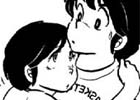Maison Ikkoku
| Genre: Comedy/Romance | ||
| Length: 14 Volumes | ||
| Allegiance: Shogakukan/Viz Communications | ||
| Mangaka: Takahashi Rumiko | ||
| Vintage: 1980-1987 | ||
| Intelligence Agency Report by: Kuzu Ryu Sen | ||
| Godai Yusaku is just your average ronin, studying for the upcoming university entrance exams. However, his life is greatly complicated by his current habitat and study environment, the infamous Maison Ikkoku. Having acquired a reputation in the neighbourhood for endless partying, the other residents of Maison Ikkoku strive to make Godai’s life a living hell. Just as Godai’s about to pack up and leave, a stroke of good fortune arrives in the form of the beautiful Otonashi Kyoko, who announces that she will be the new apartment manager! Can Godai win the fair lady’s hand, fend off his rambunctious neighbours, and complete his education? | ||
|
|
||
| Research Agent Report by: Kuzu Ryu Sen | ||
| Plot Characters Impact Visual |
8.25 9.50 9.75 7.50 |
|
| Overall | 9.25 | |
| (not an average) | ||
| Takahashi Rumiko’s works generally tend to have three things: the supernatural/paranormal, romantic comedy, and length. This formula has proven to be very successful, and has propelled Takahashi to the twin statuses of most popular female mangaka and richest woman in Japan. However, Maison Ikkoku is highly interesting as it only possesses one of the aforementioned components. Can Takahashi succeed despite deviating from her usual time frame and trademark devices? The answer, given Takahashi’s skill, is a resounding and unsurprising yes.
Despite being one of the shortest of Takahashi’s non one-shot works, Maison Ikkoku is widely touted as the one that has the deepest characterization. The members of Takahashi’s diverse cast may at first seem one-dimensional, but careful nurturing via gradual conflict creates some of the deepest and most realistic characters in manga. There are absolutely no named characters with black and white personalities. Furthermore, secondary characters not only possess depth, they acquire and utilize this depth to create emotion in the viewer without overshadowing the main characters for a second. This emphasis on characterization and the nature of the romantic comedy genre naturally means that the plot is, for the most part, rather linear and ordinary. However, while the pacing during the first half is quite slow and methodical, the story really accelerates with the introduction of Yagami Ibuki about halfway through and does not let up until the end. This makes for an exhilarating conclusion filled with suspense, confusion, surprises, and resolution. Only one major problem exists with the plot: the usage of Nanao Kozue. Kozue was intended at the outset to be a major character but remains visibly absent for the bulk of the manga, only making sporadic token appearances. Instead, several other characters such as Nozomu Nikaido and Yagami Ibuki were introduced to act as plot catalysts. The end result of these actions, aside from severe damage to Kozue’s potential, was that her involvement in critical moments was accompanied with a feeling of interruption and awkwardness. Takahashi’s art style, consisting of mostly basic lines and shapes, is one of the most famous in the industry. The art in Maison Ikkoku complies with Takahashi’s style, utilizing relatively minimal shading and no extravagant frills or coils á la CLAMP. The art style is plain, but it is not lacklustre. Takahashi, instead of using flowery and complex art, has placed a great deal of detail in terms of clothing labels, logos, clasps, shoelaces, and the like. The art is clean, detailed, and very functional. On a final note, the usage of a more European art style in the early chapters is noteworthy, although the reasoning cannot be deciphered. Maison Ikkoku is arguably Takahashi Rumiko’s finest work. Despite its relative brevity, it possesses astonishing depth in theme and characterization. It is this ability to not only maintain the 4th Wall, but also bring the audience onto the stage, that marks Maison Ikkoku as a classic in manga, and as the one of the standards for all romantic comedies today.
|
||




